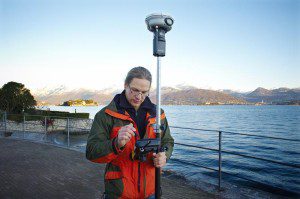Are you getting the most out of your MultiTrack prism?
Posted in: Frontier Precision, Trimble Geostpatial, Trimble Training
Many users of the Trimble S-Series robotic total stations are also using MultiTrack 360° prisms. We feel that is it important for users to know how these prisms work, as well as offer tips to get the most accurate measurements from them. First let’s go over how the MultiTrack prisms work.
As you probably first notice when looking at the prism, there are diodes all around the prism above and below the glass. These diodes are controlled by the dial on the bottom of the MultiTrack, which sets the Target ID number. The options on the dial are 1-8, which can be thought of as eight different channels. When a specific channel is selected on the dial, users need to set their target settings in Trimble Access to the same Target ID value as the prism. Once this is set, your robotic total station will only track that prism while Autolock is on, and it is in Active or Semi-Active tracking mode. Since there are eight Target ID’s available, there could technically be eight robot/MultiTrack combinations out on a job site, with all of the robots staying locked on their respective prisms. For active tracking to work properly, it is very important that the MultiTrack prisms are well maintained, and that none of the diodes get pushed in or damaged. This can cause issues with measurement accuracies, which we will detail later on.
The alternative to active tracking is something called passive tracking. Passive tracking can also be used on MultiTrack prisms, as well as other 360° or standard prisms. Passive tracking means that the robot is tracking the glass of the prism, when no RMT is available. This can be problematic however, because the robot may inadvertently lock on to anything reflective, such as a road sign, safety vest or automobile mirror.
When using a MultiTrack in active tracking mode, the prism can be positioned any way while roving. As long as the instrument can “see” the diodes, it will stay locked and track you. It is still good practice however to ensure that one of the glasses on the prism is facing the instrument when the measurement is initiated. This is especially important for measuring high accuracy points or control, and will always ensure that the instrument is not aiming at the space between the prism glasses.
If you are planning to measure in active tracking mode, there are two procedures that need to be done regularly. Both of these procedures should be done with the Multitrack prism being at least 100 meters from the instrument. The first procedure is to see if your instrument needs to have the tracker realigned by our service department. To check this, turn Autolock off and manually aim the instrument crosshairs at the center of the prism glass. Then, turn Autolock on and see if the cross-hairs have moved off the prism glass. If the cross-hairs have moved significantly and/or off the glass, you will want to consider having the robot calibrated at one of our service centers. The next procedure is to check the Autolock Collimation. The Autolock Collimation is meant to help adjust out any error in the difference between where the instrument is tracking, and where it should be measuring. These checks should be done regularly to ensure that your instrument is field calibrated. To check this, turn Autolock on and let the robot lock onto the prism. Once locked, open Survey Basic and zero the horizontal angle. Also make note of the vertical angle. Then, turn Autolock off and manually sight the center of the prism glass. If the horizontal and vertical angles change significantly, it is time to perform an Autolock Collimation. For more information on this process, contact our technical support department.
For the most part, active tracking works well for many user’s needs. However, we have run into scenarios where users are having accuracy issues with the MultiTrack prisms. Typically the discrepancies are in the vertical. In most cases, we have been able to find that the issue has to do with the diodes on the MultiTrack. Most of the diode issues have been from the diodes being pushed in or broken from misuse, or simply overspray from marking paint covering some of them. This changes the brightness of the light that the diode is emitting, which can lead to inaccurate tracking and measuring.
Issues with the diodes can easily be remedied by using semi-active tracking. Semi-active tracking uses the diodes on the MultiTrack to lock on and track the prism as it is moving. Once a measurement is initiated, the robot switches to passive tracking mode to take a measurement on the prism glass. This method takes roughly another second of time longer, but the results of the vertical accuracy are substantially better. Frontier has run controlled tests to verify this. The semi-active tracking method is not to be used as an alternative for a broken prism diode. However, for users that are looking for the most vertical accuracy out of their robotic total station and MultiTrack prism, this method is highly recommended.
For more information or questions, contact our technical support department.



